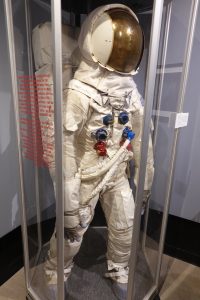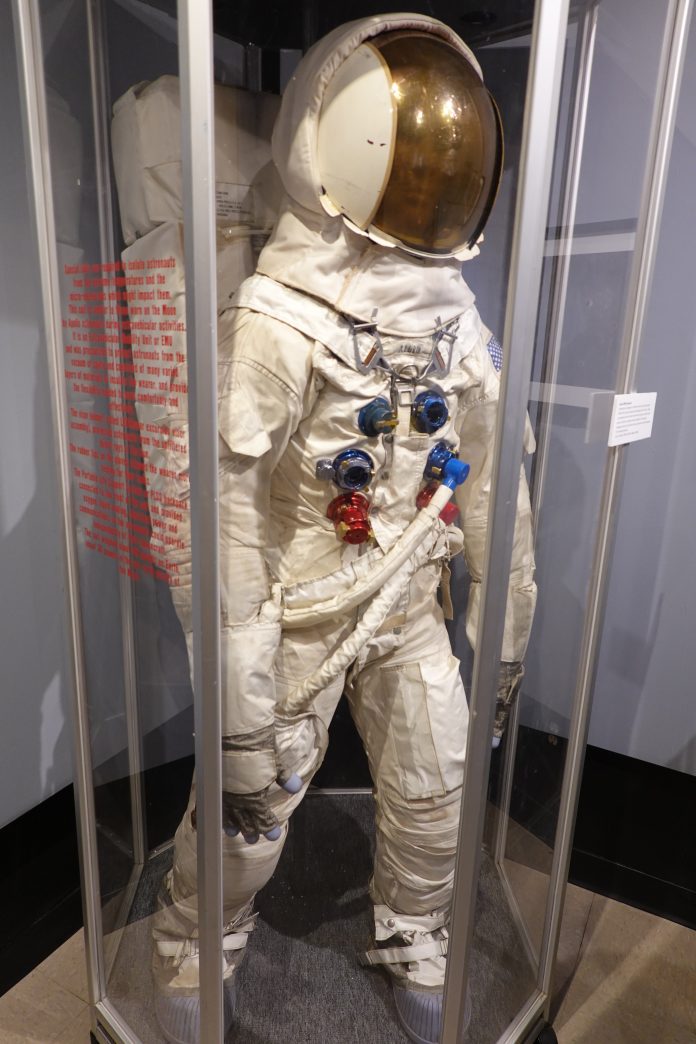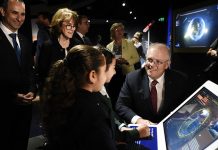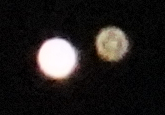A 2-room exhibit at the Arizona History Museum, entitled Ready To Launch, is designed to show Arizona’s place in space.
While it has elements of interest, the exhibit also has problems and missed opportunities. The ‘star’ of the displays is a spacesuit worn by Apollo 11 astronaut Buzz Aldrin, on loan from NASA. To be clear, this is not the suit he wore while walking on the Moon in 1969, but a training suit he wore on Earth. It is great that this rare example of a 1960s spacesuit is at this exhibit, but I can find no connexion between Aldrin, this suit and Arizona.
While the exhibit offers no information, here is what happened: NASA decided the best way to simulate what the astronauts would see when they landed on the Moon was to re-create the surface of the Moon right here in Arizona. Using strategic blasts of 300 pounds of TNT and 67 tons of ammonium nitrate, an area measuring 500 feet on a side was transformed into a landscape strewn with 47 craters ranging from small ones only 5 feet across to a 43-footer that could have swallowed the lunar lander. That was in early 1967. It was meant to mimic as nearly as possible the actual site they planned to land on two years later. Nearly a dozen astronauts trained at Cinder Lake near Flagstaff, but Aldrin but was not one of them! He trained in Sierra Blanca, Texas. Also, there is no mention that the craters can still be seen by those intrepid enough to visit this remote site. Another simulated crater field was created near Cottonwood, Arizona and was used by the Apollo 14 astronauts. This also goes unmentioned in the exhibit. In 1966 NASA tested a rocket pack powered by hydrogen peroxide and nitrogen, as a possible way astronauts could fly over the lunar surface. The tests took place right here in Arizona, in the Hopi Buttes, but this exciting rocket pack concept that thrilled those who saw the James Bond movie Thunderball is also given a pass here, so the real links between the Apollo programme and Arizona is missed.
The exhibit highlights space hardware, including the Phoenix CubeSat, a tiny satellite built in a partnership between NASA and ASU’s Undergraduate Student Instrument Project. A large colourful poster of the project is displayed, alongside information the reads in part “The Phoenix CubeSat project was awarded funding in 2016. Scheduled to launch soon, it will be the first undergraduate-student-run project of its kind.”
If you visit the webpage for the project, you will find that Phoenix was deployed from the Space Station on 19 February 2019. Shortly thereafter it went into an “error state following a loss of power event” that prevented it from completing its science objective of studying urban heat on Earth. Leading museum-goers to believe this mission has not even been launched yet is most unfortunate, to say the least.
The exhibit has a nice display on the OSIRIS-REX mission, which is now headed back to Earth with samples of the asteroid Bennu. The information display states it “is the first mission to travel to an asteroid and back with samples of the asteroid.” What about the Japanese spacecraft Hayabusa, which returned samples of an asteroid to Earth in 2010?
As an astronomer specializing in planetary science and history of astronomy, I was very much looking forward to this exhibit. However, the lack of true engagement with the Arizona in the Apollo era, and false statements on display, muted my appreciation for the effort that was made to publicise Arizona’s major contributions to space exploration.
The Arizona History Museum is open to the public Tuesday through Saturday from 10:00 a.m. to 2:00 p.m. at 949 E. 2nd St. in Tucson. Free validated parking is available at the Main Gate Garage, one block from the museum (815 E. 2nd Street). Purchase tickets at azhs.org/tickets.














